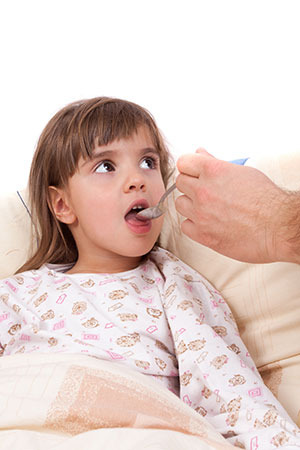It’s normal for a baby or young child to choke and cough from time to time. When it happens frequently, there could be cause for concern. These episodes are typically due to aspiration, food or liquid accidentally entering the airway. There are a number of potential causes, and your child’s doctor will develop a treatment plan based on your child’s unique case.
Signs and Symptoms
While choking and coughing are the most common signs, there are many possible symptoms that accompany swallowing disorders. They vary for babies and older children.
In babies, symptoms include:
• Choking and coughing while feeding
• Signs of discomfort during feeding, like watery eyes, irritability and grimacing
• Feeding times exceeding 30 minutes
• Face flushing or turning blue during or immediately after swallowing
• Faster or stopped breathing during feeding
• Weak sucking
• Wet-sounding breathing and vocalizations after feeding
• Slight fever after feeding
• Frequent lower respiratory infections
In older children, symptoms include:
• Choking and coughing while eating or drinking
• Frequent throat clearing
• Spontaneous choking on saliva
• Wet-sounding voice after meals
• Slight fever after meals
• Complaints of food feeling stuck
• Repeated lower respiratory infections
Some children have no obvious symptoms at all. It’s often not diagnosed until a lung infection develops.
Concerns and Complications
Repeatedly breathing in foods and liquids is more than just uncomfortable. It can pose a serious risk to your child’s health. Materials entering the airway can cause significant damage to delicate lung tissue. It can also trigger infections like aspiration pneumonia, a bacterial infection that causes fluid build up in the lungs. Pneumonia requires a long course of antibiotics to treat and can be life threatening.
In young children and babies, swallowing disorders make feeding difficult. This in turn leads to complications like dehydration, malnutrition and weight loss.
Causes and Risk Factors
The most common cause of swallowing disorders is dysphagia, a dysfunction in the muscles of the throat that control swallowing. Dysphagia is typically a symptom of a greater underlying problem, such as:
• Structural abnormalities in the palate or esophagus
• Heart disease
• Delayed growth due to premature birth, low birth weight or conditions like Down syndrome
• Nervous system problems from brain damage, cerebral palsy or other concerns
• Neuromuscular diseases like muscular dystrophy or spinal muscular atrophy
• Medical procedures involving the throat like tracheostomy or a nasogastric tube
Sometimes, the difficulty is a result of a more indirect concern like:
• Acid reflux (GERD) pushing stomach contents back into the throat
• Excessive saliva production
• Poor timing and coordination
• Rejection of certain foods due to conditions like autism
• Lethargy from other medical conditions
Getting a Diagnosis
Swallowing is split into three phases. During the oral phase, food enters and is manipulated in the mouth. In the pharyngeal phase, food is just beginning to enter the throat. The airway is supposed to close to keep food and liquid out. In the esophageal phase, the throat moves to allow food into the stomach without stomach contents coming back up. A choking problem can arise at any of these phases, and a thorough evaluation is needed to identify which one.
Your child’s consultation will begin with a thorough medical history, physical exam and possibly some blood work. You can then expect your child to get a clinical swallow evaluation. During this session, your child will be given a variety of substances to eat and drink. The doctor will evaluate your child’s movement, comfort, behavior, posture and any choking or coughing that occurs.
To get a better look at the structures in your child’s throat, two other evaluations may be recommended:
• Fiberoptic Endoscopic Evaluation: a tiny camera is inserted into your child’s throat to monitor internal structures while they swallow
• Modified Barium Swallow Study: after your child drinks a barium solution to help with imaging, swallowing is viewed via x-ray
 Treating Aspiration
Treating Aspiration
Your ENT will develop a treatment plan based on where in the swallowing process your child is having difficulty and what the underlying cause is.
Some common treatments include:
• Surgery to correct structural abnormalities like a cleft palate
• Medications or surgery to address acid reflux
• Medications or surgery to address excessive saliva production
• Changing your child’s posture and positioning during meals
• Dietary changes
• Feeding therapy, which includes things like swallowing exercises and slow introduction of new foods
• Behavior management
Most children’s swallowing disorders improve over time. Children with severe difficulty swallowing may need a feeding tube until they can eat normally. A feeding tube, or nasogastric tube, is a thin tube that runs through the nose into the stomach. Your child’s ENT will monitor your child’s condition carefully and help them transition back to normal feeding as soon as possible.
If you suspect your child is suffering from chronic aspiration, it’s important to seek treatment before serious complications arise. Give Pediatric ENT of Oklahoma a call to schedule a consultation today.

